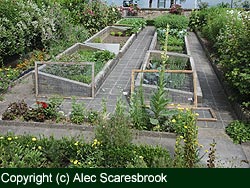Last updated March 2018
Cold frames & mini-greenhouses – uses
Designs
Points to consider
Which materials?
Essential extras
Cold frames & mini-greenhouses – uses
NB After following some of these links, you’ll have to double click the back button quickly to return to this webpage.
Cold frames (low) and mini-greenhouses (tall) are used to raise, grow on and harden off plants from seed or cuttings. They’re useful on their own, or as overflow space for your full-sized greenhouse during spring.
But be warned – we were surprised at how hot these small spaces can become on a sunny day, even in February, so someone needs to be around to adjust the ventilation during the day unless you can fit automatic vent openers, which are only suitable for rigid structures. For watering while you’re out or away, automatic irrigation is an option for most designs. Teamed up with heating, this equipment opens up a whole range of growing possibilities.
Designs
Traditional cold frames are permanent structures of brick with a removable wooden-framed glass cover (referred to as a light) – you can see these in classic kitchen gardens of stately homes.

Modern versions come in all sorts of shapes, sizes and materials, usually with clear sides replacing the solid brick walls of traditional designs. The clear sides are an improvement as they allow more light onto the plants, but are more vulnerable to damage. Plastic or twin-walled polycarbonate often replaces the glass, which may be fixed into wood, metal or plastic frames. Even the shapes differ, with tall narrow versions to fit in smaller spaces to grow taller plants where there’s not the space or budget for a greenhouse.

Points to consider
Size? Well, it has to fit in the space you have in the garden, and it has to be large enough for the plants you want to grow.
Position? Do you want to place it directly on the ground for planting into the soil? Or put it on a base (slabs or concrete) for seed trays, growbags or pots.
Height? Traditional frames are low, being designed for raising seeds and cuttings. The taller mini-greenhouse types are useful for protecting plants such as tomatoes or peppers from seedlings through to harvesting, but may require a wall to form the back of the frame, and provide support. You could also fit racks in these tall lean-to types to take lots of seed trays. Height also increases the amount of light available to your plants.
Access? How are you going to put plants into the cold frame and tend them? Some cold frames have hinged lids to lift up but these can be caught be the wind, lifted, twisted and dropped. And we found those traditional wooden framed lights to be very heavy and awkward to handle alone – drop them (we have) and inevitably you’ll break the glass (we have). Sliding panels or roll-up tops are much less damage prone.
Reach? If you site your cold frame against a building and block access to one or more sides, you need to check that you can reach the furthest points within. Otherwise you will have to stand in the frame to reach all the plants – not easy if plants are growing in the soil and a nuisance if you have to keep moving pots and trays around.
Weight? If you plan to move your cold frame or mini-greenhouse around so you can take advantage of the best spot in your garden at certain times of year, then you need to think about its weight. Wood and glass are the heaviest materials, but if the unit is easy to dismantle, it will be easier to move.
Which materials?
What materials are best for the framework and cover? That depends on your situation. And prices are difficult to compare, because each design provides a different amount of growing space and has a different lifespan. For more info, scroll down.
While horticultural glass is still the best for frost protection and light transmission (90%), and its weight helps to keep it in place in high winds, it is the most expensive glazing option, although it is cheaper than higher grade glass used for buildings. Apart from cost, you may have other things to consider, such as children’s safety or likely damage (accidental or from vandalism), that means this traditional glazing is not practical. However, toughened glass is an option, albeit more expensive than horticultural glass.
Twin-walled polycarbonate sheeting is a good substitute for glass, with 83% light transmission, and is used commercially because of its additional advantage of resistance to damage.
Acrylic glazing also has good light transmission (85%) but is quite brittle so if flexed (eg during installation or when moving panels), you could crack it.
Plastic and polythene sheeting, if UV stabilised for longevity, is also a useful frame covering, although not as long lasting as the other materials, and does enable you to roll up the sides for easy access. Single layers cannot keep the frost out well, but double-skinned covers can be as good as glass.
Whatever glazing material you use, consider extra insulation of the structure itself or the plants inside with some garden fleece or a home-made thermal blanket using polystyrene beads.
Essential accessories
NB After following some of these links, you’ll have to double click the back button quickly to return to this webpage.
Anchors are essential to prevent these structures from being dislodged – even heavy glass frames are susceptible to high winds when a vent is ajar. Bolts are good for fastening a frame onto a solid base; ground pegs for soil. Often anchors are included with the frame but you may need better ones.
For a variety of accessories, such as shading, vent openers, shelving, watering, thermometers, heaters, materials for repair…), visit Harrod Horticulture and search the greenhouse section.

